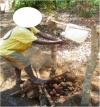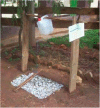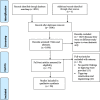Use, adoption, and effectiveness of tippy-tap handwashing station in promoting hand hygiene practices in resource-limited settings: a systematic review
- PMID: 32586314
- PMCID: PMC7316639
- DOI: 10.1186/s12889-020-09101-w
Use, adoption, and effectiveness of tippy-tap handwashing station in promoting hand hygiene practices in resource-limited settings: a systematic review
Abstract
Background: Tippy-taps are locally made devices for washing hands with running water. They are simple and low-cost, enabling technology that provides adequate water sources, handwashing stations and motivation for people to prioritise handwashing. This systematic review aimed to establish the use, benefits, adoption and effectiveness of enabling technology; tippy-tap handwashing station, in resource-limited settings.
Methods: We systematically searched for articles in the PubMed, EMBASE, PsycINFO, AMED, CINAHL, DOAJ and Google Scholar databases guided by the acceptable best practice developed by the PROSPERO and COCHRANE for systematic search and selection of articles. Search terms such as tippy-taps, enabling technology, hand-washing station, hand-washing behaviour, diarrhoea, respiratory infection, increase handwashing behaviour were used. In addition, a PRISMA flow diagram was used to elaborate on the number of articles retrieved, retained, excluded and reasons for every action. Studies that used tippy-tap hand washing station as a handwashing facility regardless of the design were included in this review. A mixed method appraisal tool was used to appraise studies.
Results: Twenty articles met the eligibility criteria. The use of tippy-taps for handwashing by household members or school children was reported by authors of 16 studies, and it ranged from 2.7 to 80%. The availability of tippy-taps increased handwashing and use of soap among participants. Furthermore, the majority of people who were oriented to tippy-taps or recruited to tippy-tap studies built their tippy-tap stations even after the promotional activities or programs had ended. In one study, tippy-taps were reported by participant to be effective in preventing episodes of stomach pain among participants.
Conclusion: Tippy-tap handwashing station could help in promoting handwashing practice in resource constraint settings. Future studies are needed to evaluate the effectiveness of tippy-tap hand washing station on preventing water and hygiene-related infections.
Keywords: Adoption; Effectiveness; Hand hygiene practice; Handwashing station; Tippy-tap.
Conflict of interest statement
The authors declare no competing interests.
Figures
Similar articles
-
Changing handwashing behaviour in southern Ethiopia: a longitudinal study on infrastructural and commitment interventions.Soc Sci Med. 2015 Jan;124:103-14. doi: 10.1016/j.socscimed.2014.11.006. Epub 2014 Nov 5. Soc Sci Med. 2015. PMID: 25461867
-
Designing a handwashing station for infrastructure-restricted communities in Bangladesh using the integrated behavioural model for water, sanitation and hygiene interventions (IBM-WASH).BMC Public Health. 2013 Sep 23;13:877. doi: 10.1186/1471-2458-13-877. BMC Public Health. 2013. PMID: 24060247 Free PMC article.
-
Hand-washing promotion for preventing diarrhoea.Cochrane Database Syst Rev. 2021 Jan 6;12(1):CD004265. doi: 10.1002/14651858.CD004265.pub4. Cochrane Database Syst Rev. 2021. PMID: 33539552 Free PMC article.
-
Effect of a water, sanitation and hygiene program on handwashing with soap among household members of diarrhoea patients in healthcare facilities in Bangladesh: a cluster-randomised controlled trial of the CHoBI7 mobile health program.Trop Med Int Health. 2020 Aug;25(8):1008-1015. doi: 10.1111/tmi.13416. Epub 2020 Jul 14. Trop Med Int Health. 2020. PMID: 32406581 Clinical Trial.
-
Rinse-free hand wash for reducing absenteeism among preschool and school children.Cochrane Database Syst Rev. 2020 Apr 9;4(4):CD012566. doi: 10.1002/14651858.CD012566.pub2. Cochrane Database Syst Rev. 2020. PMID: 32270476 Free PMC article.
Cited by
-
Nudge strategies for behavior-based prevention and control of neglected tropical diseases: A scoping review and ethical assessment.PLoS Negl Trop Dis. 2021 Nov 1;15(11):e0009239. doi: 10.1371/journal.pntd.0009239. eCollection 2021 Nov. PLoS Negl Trop Dis. 2021. PMID: 34723983 Free PMC article.
-
Innovation for improved hand hygiene: Field testing the Autarky handwashing station in collaboration with informal settlement residents in Durban, South Africa.Sci Total Environ. 2021 Nov 20;796:149024. doi: 10.1016/j.scitotenv.2021.149024. Epub 2021 Jul 14. Sci Total Environ. 2021. PMID: 34328886 Free PMC article.
-
Evaluation of the RISE II integrated social and behavior change approach in Niger: A contribution analysis.PLoS One. 2024 Jul 31;19(7):e0308185. doi: 10.1371/journal.pone.0308185. eCollection 2024. PLoS One. 2024. PMID: 39083501 Free PMC article.
-
Explaining Handwashing Behavior in a Sample of College Students during COVID-19 Pandemic Using the Multi-Theory Model (MTM) of Health Behavior Change: A Single Institutional Cross-Sectional Survey.Healthcare (Basel). 2021 Jan 6;9(1):55. doi: 10.3390/healthcare9010055. Healthcare (Basel). 2021. PMID: 33419211 Free PMC article.
-
Synthesising the evidence for effective hand hygiene in community settings: an integrated protocol for multiple related systematic reviews.BMJ Open. 2023 Nov 15;13(11):e077677. doi: 10.1136/bmjopen-2023-077677. BMJ Open. 2023. PMID: 37967997 Free PMC article.
References
-
- UNICEF. The Human Right to Water and Sanitation. Geneva: United Nations; 2015.
-
- WHO & UNICEF . Water, sanitation and hygiene in health care facilities: status in low and middle income countries and way forward. Geneva: WHO; 2015.
-
- Center for Disease Control and Prevention: Hand Hygiene in Healthcare Settings. In. USA: Center for Disease Control and Prevention; ND.
-
- Hutton G, Haller L, WHO Evaluation of the costs and benefits of water and sanitation improvements at the global level. Geneva: WHO; 2004. - PubMed
-
- UNICEF . Fact sheet: child survival fact sheet: water and sanitation. USA: UNICEF; 2004.
Publication types
MeSH terms
LinkOut - more resources
Full Text Sources
Medical
Miscellaneous




